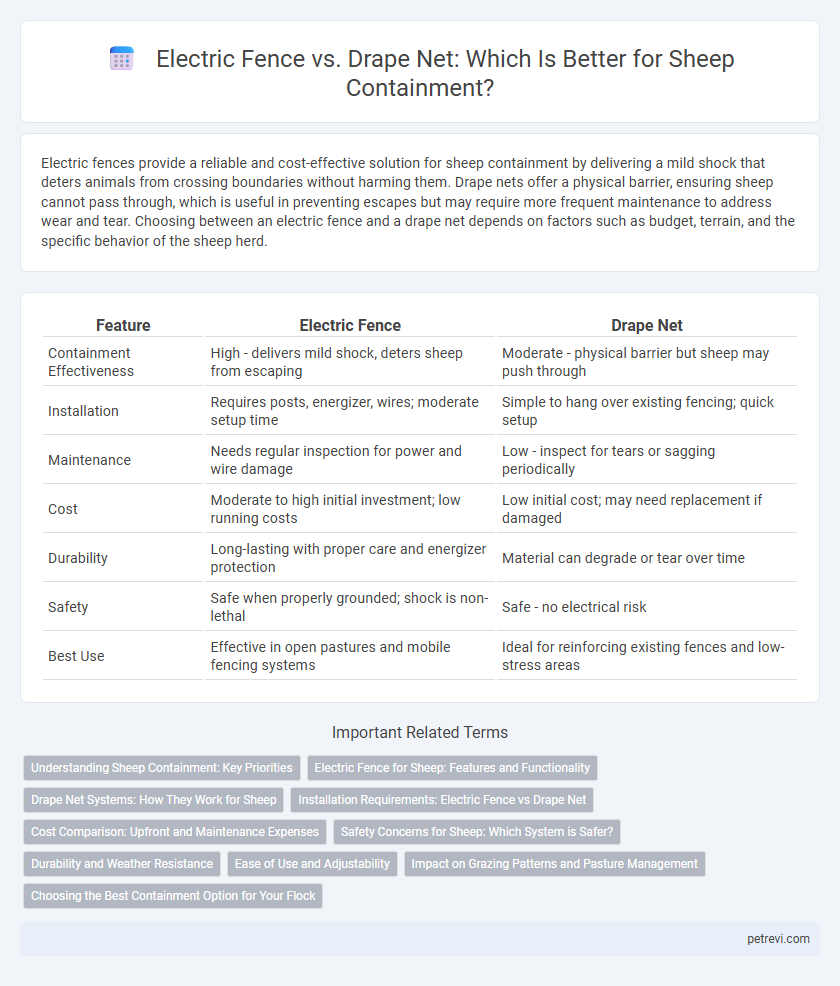Electric fences provide a reliable and cost-effective solution for sheep containment by delivering a mild shock that deters animals from crossing boundaries without harming them. Drape nets offer a physical barrier, ensuring sheep cannot pass through, which is useful in preventing escapes but may require more frequent maintenance to address wear and tear. Choosing between an electric fence and a drape net depends on factors such as budget, terrain, and the specific behavior of the sheep herd.
Table of Comparison
| Feature | Electric Fence | Drape Net |
|---|---|---|
| Containment Effectiveness | High - delivers mild shock, deters sheep from escaping | Moderate - physical barrier but sheep may push through |
| Installation | Requires posts, energizer, wires; moderate setup time | Simple to hang over existing fencing; quick setup |
| Maintenance | Needs regular inspection for power and wire damage | Low - inspect for tears or sagging periodically |
| Cost | Moderate to high initial investment; low running costs | Low initial cost; may need replacement if damaged |
| Durability | Long-lasting with proper care and energizer protection | Material can degrade or tear over time |
| Safety | Safe when properly grounded; shock is non-lethal | Safe - no electrical risk |
| Best Use | Effective in open pastures and mobile fencing systems | Ideal for reinforcing existing fences and low-stress areas |
Understanding Sheep Containment: Key Priorities
Effective sheep containment prioritizes secure, predator-resistant barriers with minimal stress to the animals. Electric fences provide a psychological deterrent through mild shocks, promoting boundary respect, while drape nets physically prevent escapes and offer a visual and tactile boundary. Both methods require regular maintenance and consideration of terrain, sheep behavior, and predator activity to ensure optimal containment and animal welfare.
Electric Fence for Sheep: Features and Functionality
Electric fences for sheep containment provide a reliable barrier by delivering a mild electric shock that discourages animals from touching or crossing the boundary. These fences typically consist of electrified wires or tapes supported by plastic or metal posts, offering flexible installation and easy relocation. The electric pulses are powered by solar panels or mains electricity, ensuring consistent functionality and low maintenance for effective sheep management.
Drape Net Systems: How They Work for Sheep
Drape net systems for sheep containment utilize flexible, high-tensile wires suspended between sturdy posts, creating a physical and psychological barrier that discourages sheep from attempting to breach it. The nets' visibility and slight movement in the wind deter sheep effectively without the need for electric shocks, reducing stress and injury risk. Their efficient modular design allows quick installation and adaptability to various terrains, ensuring secure grazing areas while minimizing maintenance costs.
Installation Requirements: Electric Fence vs Drape Net
Electric fences require sturdy posts driven deep into the ground with properly tensioned wires connected to an energizer, demanding careful alignment and electrical safety measures. Drape nets need robust support structures such as poles or trees to suspend the mesh, ensuring even tension to prevent sagging and gaps. Both systems necessitate regular inspection and maintenance, but electric fences often involve more complex installation due to electrical components and grounding requirements.
Cost Comparison: Upfront and Maintenance Expenses
Electric fences generally have lower upfront costs ranging from $1 to $3 per meter, making them a budget-friendly option for sheep containment. Maintenance expenses can vary, but regular checks and occasional battery replacements keep costs relatively low compared to drape nets. Drape nets, while offering enhanced durability and predator protection, require higher initial investments typically between $10 and $15 per meter and incur greater maintenance due to cleaning and damage repairs.
Safety Concerns for Sheep: Which System is Safer?
Electric fences provide effective sheep containment by delivering low-voltage shocks that discourage escape without causing serious injury, ensuring a balance between security and animal welfare. Drape nets, designed as physical barriers, eliminate electrical risks but may pose injury hazards if sheep attempt to push through or become entangled. Analyzing injury rates and escape incidents, electric fences tend to be safer overall due to their deterrent effect and reduced physical harm compared to the potential abrasions or entrapment associated with drape nets.
Durability and Weather Resistance
Electric fences offer high durability and strong weather resistance due to UV-stabilized wires and insulated posts designed for various climates. Drape nets, while effective for temporary containment, typically degrade faster under harsh weather conditions such as heavy rain or intense sun exposure. Choosing electric fencing ensures long-term resilience and reduced maintenance in diverse environmental settings for sheep containment.
Ease of Use and Adjustability
Electric fences offer quick setup and simple adjustability, allowing for easy modification of height and tension to accommodate various sheep sizes and grazing patterns. Drape nets provide a flexible barrier that can be easily repositioned or expanded but may require more effort to secure properly and maintain tension over time. Both options support effective containment, but electric fences typically deliver greater convenience in routine adjustments and ease of use.
Impact on Grazing Patterns and Pasture Management
Electric fences influence sheep grazing patterns by encouraging more controlled and rotational grazing, which supports pasture recovery and reduces overgrazing. Drape nets, while primarily used for predator protection, restrict sheep movement less rigidly, potentially leading to uneven grazing and patchy pasture utilization. Effective pasture management benefits from electric fences' ability to segment grazing areas, promoting uniform forage use and improved soil health.
Choosing the Best Containment Option for Your Flock
Electric fences provide effective, low-maintenance containment for sheep by delivering mild shocks that discourage escape, making them ideal for larger or irregular pastures. Drape nets offer a physical barrier that is durable and visually discouraging, suitable for smaller areas or where continuous power supply for electrification is an issue. Selecting the best option depends on pasture size, terrain, flock behavior, and budget constraints to ensure secure and stress-free sheep containment.
Electric Fence vs Drape Net for Sheep Containment Infographic

 petrevi.com
petrevi.com